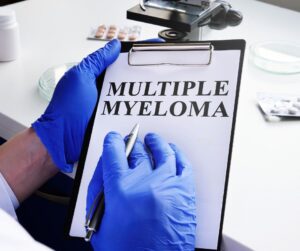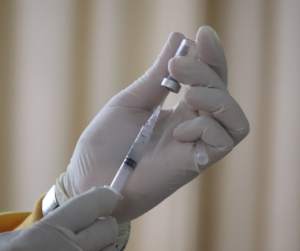Stephen Michael Clark, PharmD BCOP
There have been some exciting advancements in immunotherapy for cancer in the past year, particularly hematologic malignancies. One such advancement is a group of therapies known as bispecific antibodies. Bispecific antibodies are engineered to bind to 2 different targets. The most promising way to use bispecific antibodies thus far has been to engineer them to bind to an antigen primarily found or overexpressed on cancer cells and bind to a second target on an immune effector cell such as CD3 on T cells.1 This approach directs the immune system to destroy the targeted cancer cells.
In 2014, blinatumomab (Blincyto, Amgen) became the first bispecific antibody approved in the United States.2 It was originally given approval for relapsed/refractory B-cell precursor acute lymphoblastic leukemia (ALL). In 2018 blinatumomab received accelerated approval for B-cell ALL in first or second complete remission with minimal residual disease (MRD) greater than or equal to 0.1%. This second indication gave blinatumomab a new role to deepen and maintain responses in ALL patients before relapse occurred. Since the introduction of blinatumomab, there have been a number of bispecific T-cell-engaging antibodies with recently granted accelerated Food and Drug Administration (FDA) approvals (see Table).
Table. Bispecific T-cell-Engaging Antibodies Granted FDA Accelerated Approval in 2022-2023
| Drug | Malignant Target | Indication | Outcomes (95% Confidence Interval) |
| Teclistamab (Tecvayli, Janssen Oncology) | BCMA | R/R MM, 5th line or later | ORR 61.8% (52.1, 70.9) DOR 66.5% (38.8, 83.9) at 9 months |
| Talquetamab (Talvey, Janssen Oncology) | GPRC5D | R/R MM, 5th line or later | Weekly dosing ORR 73% (63.2, 81.4) Median DOR 9.5 months (6.5, not estimable) |
| Biweekly dosing ORR 73.6 % (63.0, 82.4) Median DOR not estimable | |||
| Mosunetuzumab (Lunsumio, Genentech) | CD20 | R/R FL, 3rd line or later | ORR 80% (70, 88) Median DOR 22.8 months (10, not estimable) |
| Glofitamab (Columvi, Genentech) | CD20 | R/R DLBCL or LBCL arising from FL, 3rd line or later | ORR 56% (47, 65) Median DOR 18.4 months (11.4, not estimable) |
| Epcoritamab (Epkinly, Genmab/AbbVie) | CD20 | R/R DLBCL, including DLBCL arising from indolent lymphoma and high-grade B-cell lymphoma, 3rd line or later | ORR 61% (52.5, 68.7) Median DOR 15.6 months (9.7, not estimable) |
BCMA, B-cell maturation antigen; DLBCL, diffuse large B-cell lymphoma; DOR, duration of response; FL, follicular lymphoma; GPRC5D, G protein-coupled receptor class C group 5 member D; LBCL, large B-cell lymphoma; MM 5th line or later, multiple myeloma after at least 4 lines of treatment, including a proteasome inhibitor, an immunomodulatory agent, and an anti-CD38 monoclonal antibody; ORR, overall/objective response rate; R/R, relapsed or refractory.
Toxicities Associated with Bispecific T-Cell–Engaging Antibodies
While immunotherapy may have the benefit of avoiding some of the toxicities of traditional chemotherapy, bispecific T-cell–engaging antibodies have their own serious toxicities, including cytokine release syndrome (CRS) and immune effector cell-associated neurotoxicity syndrome (ICANS).3-7 Both CRS and ICANS can be fatal and thus must be recognized early and treated accordingly.8 Before treating patients with bispecific T-cell–engaging therapies, it is imperative to have a plan in place on how to monitor and treat CRS and ICANS. There are currently no guidelines that were specifically developed for bispecific antibodies; however, much of what we know about CRS and ICANS is derived from the experience with chimeric antigen receptor (CAR) T-cell therapy and can be applied to bispecific antibodies.9-10 Using the most up-to-date guidelines from the American Cancer Society or the National Comprehensive Cancer Network can provide a good foundation for educating the staff and developing a practice site-specific treatment plan. Readily available access to rescue medications such as intravenous fluids, steroids, and tocilizumab is imperative. A standardized approach to treatment of CRS and ICANS among the bispecific antibodies may promote appropriate and prompt treatment.
Standardized vs. Agent-Specific Monitoring
While developing CRS and ICANS monitoring and treatment plans, consider what should be standardized across various agents and what should be agent specific. For instance, initial treatment of CRS and ICANS may be standardized, but the duration of monitoring after giving a dose may differ between agents due to differences in the incidence and time to onset of CRS depending on the dose the patient has received in each agent’s ramp-up schedule. These differences may influence approaches to outpatient versus inpatient monitoring. Additionally, some agents have specific recommendations regarding inpatient monitoring duration and Risk Evaluation and Mitigation Strategy programs. Finally, consult each agent’s ramp-up schedule and dose interruption recommendations following CRS or ICANS for guidance on if restarting an agent can be considered and at what dose and schedule.
In conclusion, several bispecific T-cell–engaging antibodies are now available in the U.S. for hematologic malignancies based on early response data in later lines of therapy. The 5 accelerated approvals reviewed above are contingent on demonstrating clinical benefit and safety in follow-up studies. Clinicians should be prepared for monitoring and treating CRS and ICANS as well as agent-specific toxicities detailed in the prescribing information.

References
- Duell, J., Lammers, P. E., Djuretic, I., Chunyk, A. G., Alekar, S., Jacobs, I., & Gill, S. (2019). Bispecific Antibodies in the Treatment of Hematologic Malignancies. Clinical pharmacology and therapeutics, 106(4), 781–791.
- U.S. Food & Drug Administration. Drugs @ FDA: FDA-Approved Drugs. Retrieved August 14, 2023, from https://www.accessdata.fda.gov/scripts/cder/daf/index.cfm?event=overview.process&varApplNo=125557
- Tecvayli (teclistamab-cqyv) [prescribing information]. Horsham, PA: Jannssen Biotech, Inc.; 2022.
- Talvey (talquetamab-tgvs) [prescribing information]. Horsham, PA: Jannssen Biotech, Inc.; 2023.
- Lunsumio (mosunetuzumab-axgb) [prescribing information]. South San Francisco, CA: Genentech, Inc.; 2022.
- Columvi (glofitamab-gxbm) [prescribing information]. South San Francisco, CA: Genentech, Inc.; 2023.
- Epkinly (epcoritamab-bysp) [prescribing information]. Plainsboro, NJ: Genmab US Inc.; 2023.
- Lee, D. W., Santomasso, B. D., Locke, F. L., Ghobadi, A., Turtle, C. J., Brudno, J. N., Maus, M. V., Park, J. H., Mead, E., Pavletic, S., Go, W. Y., Eldjerou, L., Gardner, R. A., Frey, N., Curran, K. J., Peggs, K., Pasquini, M., DiPersio, J. F., van den Brink, M. R. M., Komanduri, K. V., … Neelapu, S. S. (2019). ASTCT Consensus Grading for Cytokine Release Syndrome and Neurologic Toxicity Associated with Immune Effector Cells. Biology of blood and marrow transplantation: journal of the American Society for Blood and Marrow Transplantation, 25(4), 625–638.
- Morris, E. C., Neelapu, S. S., Giavridis, T., & Sadelain, M. (2022). Cytokine release syndrome and associated neurotoxicity in cancer immunotherapy. Nature reviews. Immunology, 22(2), 85–96. https://doi.org/10.1038/s41577-021-00547-6
- Santomasso, B. D., Nastoupil, L. J., Adkins, S., Lacchetti, C., Schneider, B. J., Anadkat, M., Atkins, M. B., Brassil, K. J., Caterino, J. M., Chau, I., Davies, M. J., Ernstoff, M. S., Fecher, L., Funchain, P., Jaiyesimi, I., Mammen, J. S., Naidoo, J., Naing, A., Phillips, T., Porter, L. D., … Ghosh, M. (2021). Management of Immune-Related Adverse Events in Patients Treated With Chimeric Antigen Receptor T-Cell Therapy: ASCO Guideline. Journal of clinical oncology: official journal of the American Society of Clinical Oncology, 39(35), 3978–3992.







